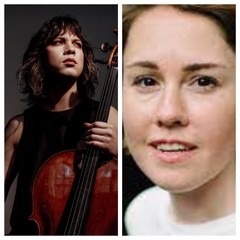|
Back
Strings and Candelight New York
Catacombs, Green-Wood Cemetery
09/08/2021 -
“Death of Classical”: “Music For Two People”
Caroline Shaw: Sarabande from Partita For Eight Voices – In Manus Tuas – By & By – Limestone & Felt
Andrew Yee: The Trees of Green Wood – The Light after
Oliver Messiaen: V. Louange à l’Éternité de Jésus from Quartet for the End of Time
Caroline Shaw (Vocals, Violin), Andrew Yee (Cello)

A. Yee/C. Shaw (© Courtesy of the Artist/Pitchfork.com)
“Performing and listening to a gradual musical process resembles...placing your feet in the sand by the water’s edge and watching, feeling and listening to the waves gradually bury them.”
Steve Reich (1936)
“The flavor added by the sun, moon and stars shining on our people as they built a nation in the wilderness...The old songs of our progenitors have been reborn. They are now more intense, wilder, more ribald, embodying greater pitch variety and rhythmic freedom.”
Roy Harris (1898-1979)
Nobody has ever described Caroline Shaw as an echt-Harris folk singer. Still, just as Bartók breathed Hungary in his most un-Hungarian music, Ms. Shaw breathes the autumnal breaths of the Appalachian in her voice, her violin, her composition. She is an American Original. And listening to an hour of her voice and fiddle beside the inhumanly cello virtuosity of Andrew Yee became an hour which precludes words or speech.
Mind you, Nature prepared this writer for the concert. The sung glowed yesterday but with a comfortable, not searing heat. The tens of thousands of trees of Green-Wood cemetery–the maples and elms, the sassafras and the beech trees–were wearing their most elegant green a month before their radiant autumnal demise.
And as we strolled to the Cemetery Catacomb, it was easy to forget those ugly massive crypts and vaults. (“Hey! They’re dead. Put ’em in the earth and let the worms and maggots enjoy themselves without all that damned cement.”) and concentrate on this heavenly arbors and gentle hillsides.
In a sense, Ms. Shaw has not grown but blossomed from her Pulitzer Prize-winning Partita some eight years ago. Her association with the most diverse artists and ensembles has not destroyed her North Carolina heritage so much as broadening it. And in Roy Harris’ words, she has become “more intense, wilder.”
Not wilder in an emotional sense, but in taking on one of the great 20th Century composers, Olivier Messiaen. Yet Ms Shaw with cellist Yee, started with her most famous piece, written seven years ago, the Sarabande from Partita. The original work was an a capella miracle with the music of A Roomful of Teeth. Here, Ms Shaw repeated those voices–but here Andrew Yee, with infinite figurations, gave cello the ultimate role.
The opposite occurred with the fifth sacrament (not the insipid word “movement”) from Quartet for the End of Time. The original was for cello and piano. Andrew Yee started with the Messiaen solo. After a few seconds, Caroline Shaw’s voice intoned a series of descants, other hymns, a vocalise which actually broadened out the music. One feels that the composer, with his wide joy of anything which smacked of elation, would have been..yes, elated.
The other works were by the artists themselves. In Manus Tuas was Carolyn Shaw’s paean to a motet by Thomas Tallis. Yet Andrew Yee’s magic of cello legerdemain had little of Tallis. Instead, it was a celebration of harmonic technique, as well as a celebration of darkness and candlelight. What had seemed a thesaurus of moods had a central startling section, modal measures which (I assume) were part of the Tallis.
Ms Shaw gave another voice of the sacred with a late 19th Century hymn, By & By. The first line of her song, “I am thinking today of that beautiful land I shall reach when the sun goeth down...” started and finished with Ms. Shaw’s vocal genius against the complex cello figurations.
It was a remembrance of tones past. The first time I heard her, I thought of the early Joan Baez. The identical purity, the spot-on pitch and diction, the almost uncanny feeling that each word was (in John Cage’s sense) a world unto its own.
Here, Ms. Shaw didn’t confine herself to the song. Her highest notes aren’t operatic: rather they have a pure singluarity. In her lower tones, she possesses a soft, sometimes whispery power.
After more cello and vocalizations (including Andrew Yee’s celebration of the tree diversity) Caroline Shaw brought our her violin for the duet Limestone & Felt. Like all her music, the feelings were far more than the title. At first, we heard a duet of pizzicati by violin and cello. From here, she had created a dichotomy of canons and mystical chordings, the strings playing against one another, colliding with fragility, with iridescence and–for Ms. Shaw’s artistry is sculpted with her innate craft–an underlying unity.
My only error? Going back through Green-Wood as the sun was going down, the other riders declaiming how “good”, how “really beautiful” it was. I was speechless, and until this unworthy epistle, utterly wordless.
Harry Rolnick
|